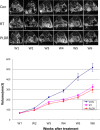Local Tumor Control and Normal Tissue Toxicity of Pulsed Low-Dose Rate Radiotherapy for Recurrent Lung Cancer: An In Vivo Animal Study
- PMID: 26675811
- PMCID: PMC4674173
- DOI: 10.1177/1559325815588507
Local Tumor Control and Normal Tissue Toxicity of Pulsed Low-Dose Rate Radiotherapy for Recurrent Lung Cancer: An In Vivo Animal Study
Abstract
Objectives: This study investigates (1) local tumor control and (2) normal tissue toxicity of pulsed low-dose rate radiotherapy (PLDR) for recurrent lung cancer.
Methods: For study 1, nude mice were implanted with A549 tumors and divided into the following 3 groups: (1) control (n = 10), (2) conventional radiotherapy (RT; n = 10), and (3) PLDR (n = 10). Tumor-bearing mice received 2 Gy daily dose for 2 consecutive days. Weekly magnetic resonance imaging was used for tumor growth monitoring. For study 2, 20 mice received 8 Gy total body irradiation either continuously (n = 10) or 40 × 0.2 Gy pulses with 3-minute intervals (n = 10).
Results: For study 1, both conventional RT and PLDR significantly inhibited the growth of A549 xenografts compared with the control group (>35% difference in the mean tumor volume; P < .05). The PLDR results were slightly better than conventional RT (8% difference in the mean tumor volume; P > .05). For study 2, the average weight was 20.94 ± 1.68 g and 25.69 ± 1.27 g and the survival time was 8 days and 12 days for mice treated with conventional RT and PLDR (P < .05), respectively.
Conclusion: This study showed that PLDR could control A549 tumors as effectively as conventional RT, and PLDR induced much less normal tissue toxicity than conventional RT. Thus, PLDR would be a good modality for recurrent lung cancers.
Advances in knowledge: This article reports our results of an in vivo animal investigation of PLDR for the treatment of recurrent cancers, which may not be eligible for treatment because of the dose limitations on nearby healthy organs that have been irradiated in previous treatments. This was the first in vivo study to quantify the tumor control and normal tissue toxicities of PLDR using mice with implanted tumors, and our findings provided evidence to support the clinical trials that employ PLDR treatment techniques.
Keywords: A549 xenograft model; normal tissue toxicity; pulsed low-dose rate radiotherapy (PLDR); total body irradiation (TBI); tumor growth.
Conflict of interest statement
Figures






References
-
- Bourhis J, Sire C, Graff P, et al. Concomitant chemoradiotherapy versus acceleration of radiotherapy with or without concomitant chemotherapy in locally advanced head and neck carcinoma (GORTEC 99-02): an open-label phase 3 randomised trial. Lancet Oncol. 2012;13(2):145–153. - PubMed
-
- Jones A. The untreated patient with squamous carcinoma of the head and neck. Am J Clin Oncol. 1995;18(4):363. - PubMed
-
- Blackstock AW, Govindan R. Definitive chemoradiation for the treatment of locally advanced non-small-cell lung cancer. J Clin Oncol. 2007;25(26):4146–4152. - PubMed
-
- Paleri V, Kelly C. Re-irradiation with concurrent chemotherapy in recurrent head and neck cancer: a decision analysis model based on a systematic review. Clin Otolaryngol. 2008;33(4):331–337. - PubMed
LinkOut - more resources
Full Text Sources
Other Literature Sources

